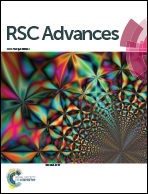Characterizing the distribution of organic matter during composting of sewage sludge using a chemical and spectroscopic approach†
Abstract
The present study aimed to investigate the evolution of organic matters during sewage sludge composting with different carbon additives including glucose, sucrose and straw. The organic matters were divided into a hot water soluble fraction (SOL-H2O), neutral detergent soluble fraction (SOL-ND), hemicellulose-like fraction (HEM), cellulose-like fraction (CEL) and lignin-like fraction (LIG) by a modified Van Soest procedure. Parallel factor (PARAFAC) analysis was applied to identify the number of fluorescent components in excitation–emission matrixes (EEMs) and its relative concentration in each water extractable organic matter (WEOM) sample. The results showed that the degradation of total organic carbon (TOC) in SOL-H2O and SOL-ND, as well as HEM and CEL fractions was accelerated by adding glucose and sucrose. While the straw powder increased the amount of TOC in the HEM and CEL fractions, no promotion on the degradation of TOC was observed. Four components including humic-like, tryptophan-like, microbial byproduct-like and fulvic-like substances were identified by PARAFAC analysis of EEMs. The percentage of humic-like substances in the composted material increased from 42.7% to 51.6% due to the addition of sucrose. The results suggested that adding glucose and sucrose in sewage sludge composting could promote the degradation and humification of organic matters.


 Please wait while we load your content...
Please wait while we load your content...